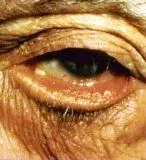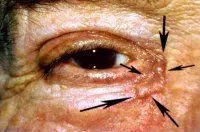Eye Physicians Inc. is proud to offer the following in nonsurgical, physician-administered treatment. Contact EPI for more information about BOTOX® or visit the web link below.
BOTOX® Cosmetic is a simple, nonsurgical, physician-administered treatment that can temporarily smooth moderate to severe frown lines between the brows in people from 18 to 65 years of age. It is the only treatment of its type approved by the Food and Drug Administration (FDA). Visit: botoxcosmetic.com
Baggy Eyelids
Baggy eyelids (dermatochalasis) develop as a result of hereditary tendencies and aging changes in the eyelids. Blepharoplasty is the operation designed to improve the appearance of baggy eyelids. This operation is often performed for cosmetic purposes. But is also frequently requested by older individuals to resolve visual problems caused by the excess tissue.
Before

After

Droopy Eyelids (Ptosis)
Droopy eyelids (ptosis) may be caused by many factors but most commonly results from either a birth defect or aging changes in the eyelid. Various surgical techniques are available to the ophthalmic surgeon to correct this condition depending on the amount of muscle function present in the affected eyelids.
If there is adequate muscle function, the surgeon will shorten the muscle to effectively strengthen it and raise the eyelid. If there is little or no muscle function in the droopy eyelids, the surgeon will use a "Sling" operation to mechanically raise the eyelid.
An eyebrow lift or eyelid lift (ptosis repair) may be done in conjunction with blepharoplasty when drooping has occured in these structures.
Before

After

Transconjunctival Blepharoplasty
This wonderful lower eyelid surgical technique is done as a local procedure. It involves the removal of the extra or prolapsed orbital fat (which usually serves as a cushion around the eye) below the eyeball which partially pushes forward through the lower lid septum (which is like a thin wall or curtain holding the fat back in place). As we get older, this septum weakens and allows the fat to herniate forward, causing unsightly fullness of the lower lids (or "bags").
"Transconjunctival" means we are reaching the "fat bag" through the conjunctiva, which is the inside lining of the lower lid. This avoids the skin surface, muscles and the other outside tissues, therefore minimizing the possibility of lower lid retraction as the skin incision heals.
It is felt that this technique should only be done by experienced ophthalmic surgeons, as this surgery is done close to the globe and near the muscles of the globe; particularly the inferior oblique muscle. The prolapsed fat is removed through this conjunctival incision which lines the back of the eyelid and the eyeball itself. As we stated above, this eliminates an unsightly scar and many of the potential complications of the blepharoplasty done from the skin surface, which is most common.
However, not everyone is a candidate for this procedure. The procedure is most appropriate for younger patients with prominent lower lid bags, good skin tone and elasticity of the lower lid. Some patients, in addition to needing fat removed from the inside of the lower lid, may also require removal of excessive redundant folds of skin from the lower lids.
Transconjunctival blepharoplasty is felt to be superior to taking out the fat through the orbital septum on the skin surface. This procedure is particularly invisible to the naked eye and truly restores a more youthful appearance and preserves full function of the lids. (Also, at times, it can cut down on the excessive pigmentation of the lower lid because of the convexity or foward bulging of the fat.) As the fat is removed the lower skin is now a more concave, normal position. We definitely recommend this procedure over the normal skin blepharoplasty and eyelid surgery when it is possible.
Post operative care is improved because there is a diminished possibility of buried suture granuloma or suture reaction. There are usually no sutures which need to be removed; as any sutures placed, if any, are absorbed. Post operative care usually consists of drops, ointments, and ice packs to the eyes.
If you are interested in this new oculoplastics procedure, please ask us.
Eye Deformities
Eyelid deformities (entropion, ectropion) are often caused by aging changes and can be painful, unattractive, and even dangerous to the eye itself. These deformities can usually be corrected by surgery.
Entropion

Ectropion

Scars
Scars in the eyelids and face can often be made less noticeable. For example any eyelid scar interfering with downward movement of the upper eyelids may require a skin graft. The ophthalmic surgeon experienced in plastic and reconstructive surgery will choose the most appropriate scar revision technique for each patient.
Trauma
Trauma may result in injury to the soft tissue and/or the bones of the face. Precise evaluation and repair of these injuries is necessary to insure the best possible appearance and function. This is especially true of the eyelids and bones around the eye.
Eyelid Cancer
Eyelid cancer (malignancy) must be treated early and correctly in order to avoid complications of delayed or improper treatment. Proper surgical removal of the tumor usually offers the best chance of permanently eliminating the tumor. Once a tumor is removed, the ophthalmic surgeon then surgically rebuilds the affected eyelids.

Basal Cell Carcinoma
Loss of an eye (anophthalmos) either because of an accident or a disease is difficult to accept. An attractive artificial eye that fits properly helps patients cope with the crisis. Inability to retain an artificial eye in the socket is only one of the many problems that may develop.
The ophthalmic surgeon performs surgical procedures in the socket and eyelids to improve the fit and appearance of the artificial eye. He also works closely with the artificial eye technician (ocularist) to insure that the patient who has lost an eye has the benefit of the latest advances in custom made artificial eye and fitting techniquies.
Birth Defects
Birth defects (congenital) are certainly not limited to the eyelids, but those affecting the eyelids are among the most challenging problems undertaken by the ophthalmic surgeon. When these conditions are complicated, they often require several operations to effect a satisfactory result.
Tearing
Tearing is a very common sympton sometimes caused by eyelid changes or disease in the tear secreation or drainage systems. Medical and/or surgical treatment is usually successful in relieving these bothersome problems.



